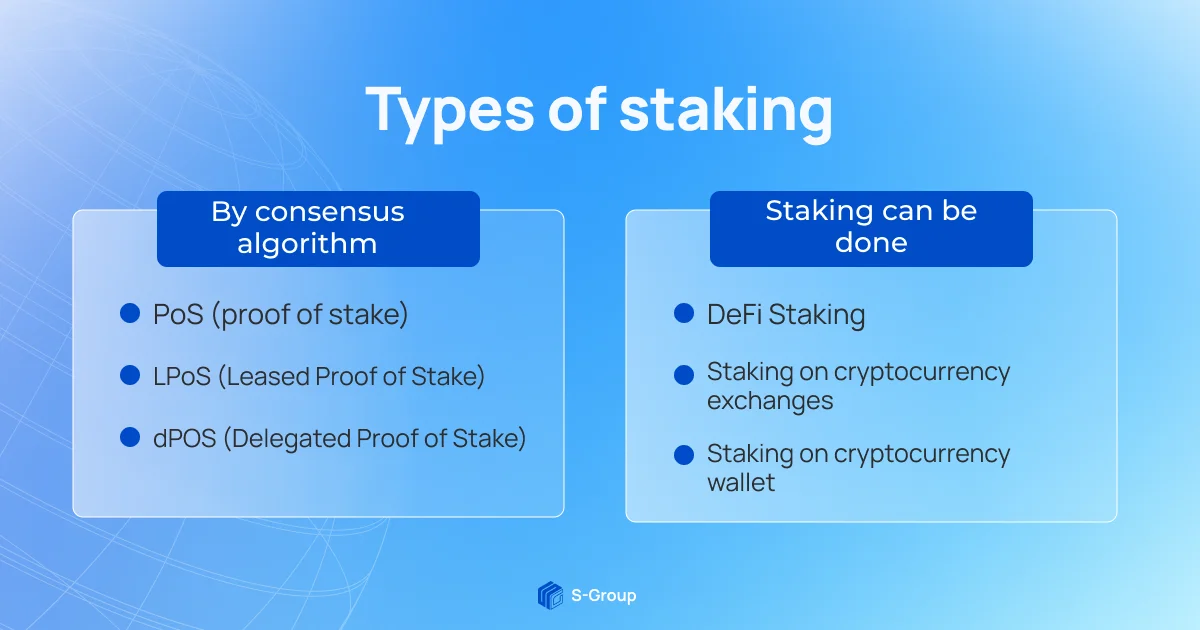What kinds of staking there are

Staking and mining are two of the most well-known ways to make money from cryptocurrencies. Stacking works on the PoS (proof-of-stake) algorithm, while mining works on PoW (proof of work).
The main difference between these methods is that you need to buy expensive and powerful equipment for mining, which keeps the network running. The income depends on how powerful the miner's equipment is.
In stacking, the network performance is maintained by investor contributions. User freezes some coins in his wallet, gives them to network and receives interest for storage — 6-10% per year.
Types of staking
Stacking can be classified into two categories:
- Consensus algorithm (a consensus opinion on which transaction is considered correct)
- The place where it is being staked.

According to the consensus algorithm, a distinction is made between PoS, Leased Proof of Stake and dPOS stacking.
PoS (proof of stake)
Proof of Stake is a blockchain protection algorithm in which unconfirmed transactions are secured by frozen funds in investors' wallets. The more coins frozen in a user's account, the higher the probability that the network will select the investor as a validator, and they will be rewarded.
Compared to Proof of Work, where miners compete to mine the next block through hard computational work, validators on PoS are selected based on the amount of cryptocurrency the system has.
LPoS (Leased Proof of Stake)
The Leased Proof of Stake algorithm translates to “the least share proof” and is considered an improved version of PoS. With LPoS, users can rent coins to nodes (a network node that is connected to a blockchain) and receive interest in return. Users collectively fill a node with coins, which increases its chance of being selected as a validator, mining a new block and making a profit. In addition, the user has the ability to take back the funds he gave up at any time and dispose of them as he sees fit.
dPOS (delegated proof of stake)
The main advantage of this algorithm is that a user with even a minimal amount of cryptocurrency can participate in staking. Stakeholders (coin holders) vote for validators (delegates) — those who will verify transactions, form blocks, and ensure that the network is up and running. The chosen delegates process transactions and receive transaction fees for themselves and the users who delegated tasks to them. The delegates keep a portion of the profits as a reward for their work, and the commission they receive is sent to the stackholders.
Staking can be done on DeFi markets, cryptocurrency exchanges and wallets.
DeFi Stacking
DeFi Stacking is a way of passive income in a system of decentralized finance. DeFi (Decentralized Finance) are blockchain-based applications/services that can be a great alternative to the banking system.
Decentralized finance differs from centralized finance in that it does not have a single authority that controls transactions and the entire infrastructure. Instead of a single controlling authority, decentralized finance uses smart contracts (software code that tracks the execution of agreements between parties).
With DeFi Stacking, investors make money by filling liquidity pools (token stocks that are locked into a smart contract account) with their cryptocurrency and are rewarded for doing so.
The advantages of DeFi Stacking include high returns and a low entry threshold. For example, to take part in Ethereum PoS Stacking, you will need 32 ETH coins ($129,521). In DeFi Stacking, a minimum amount of cryptocurrency will be enough (the amount depends on the specific coin), since there are a lot of participants.
Staking on cryptocurrency exchanges
A convenient and simple option of passive income for a beginner. In this case, you don't need to understand on your own how blockchain works, what is inflation, etc. You simply transfer these obligations to a third party, an exchange, and fund your account with a certain amount of coins to start stacking.
Binance is considered to be the best cryptocurrency exchange for stacking. The process of staking on Binance is intuitive, and the period of freezing funds does not exceed a period of a few days.
Staking in cryptocurrency wallets
As in the case of cryptocurrency exchanges, staking in wallets does not require any specialized knowledge and skills from a person. It is enough just to freeze a certain amount of coins in one's account. Compared to staking on cryptocurrency exchanges, this option is safer because the funds remain with the user in the wallet.
Conclusion
The emergence of new types of staking gives users more and more opportunities to get started with passive cryptocurrency investing without having powerful equipment and many coins in their account. If you choose the option of staking in wallets or on cryptocurrency exchanges, you will not need any special knowledge, as a third party takes care of all the technical aspects.
In our next articles, we will take a closer look at staking strategies and predictions from experts. Stay tuned.
Share
Interesting
Would you like to receive a digest of articles?
One email with the best articles of the week.
Sign up so you don't miss anything.